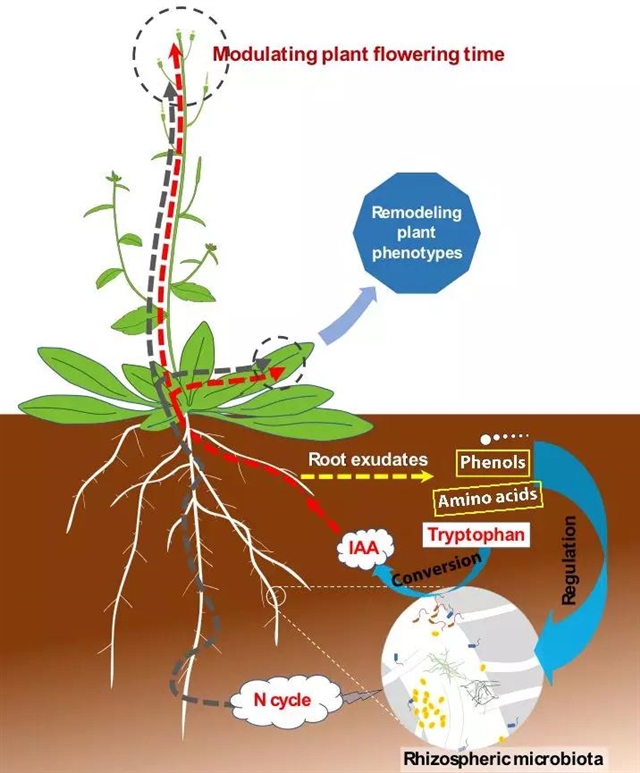|
|
| 花儿为什么这时开?微生物知道答案 | Microbiome |
|
论文标题:Rhizosphere microorganisms can influence the timing of plant flowering
期刊:Microbiome
作者:Tao Lu†, Mingjing Ke†, Michel Lavoie, Yujian Jin, Xiaoji Fan, Zhenyan Zhang, Zhengwei Fu, Liwei Sun, Michael Gillings, Josep Peñuelas, Haifeng Qian and Yong-Guan Zhu
发表时间:2018/12/26
数字识别码:10.1186/s40168-018-0615-0
原文链接:https://microbiomejournal.biomedcentral.com/articles/10.1186/s40168-018-0615-0?utm_source=other&utm_medium=other&utm_content=null&utm_campaign=BSCN_2_DD_MicroBiome_Arti_Scinet
微信链接:https://mp.weixin.qq.com/s/TPhPMML3A_soPe8StlXrYw
浙江工业大学钱海丰教授团队和中科院城市环境研究所朱永官研究员团队合作,于2018年12月在微生物组学领域期刊Microbiome上发表题为 “Rhizosphere microorganisms can influence the timing of plant flowering” 的论文。
该论文揭示了植物(拟南芥)根系分泌物、根际微生物群和植物之间的相互作用机制,并首次将土壤N循环,植物激素吲哚乙酸(IAA)和开花时间联系起来,从而绘制了一个全新的分子相互作用网络。该研究发现,在植物根际分泌物重塑根际微生物的同时,根际微生物可通过调节土壤N循环和分泌植物激素(如IAA)来反馈调控植物的生长和开花。

阐明植物物候现象(如植物开花时间的变化)对于推进人类的农林牧业发展至关重要。已有很多学者对影响植物物候现象的若干重要驱动因素进行了研究,但其与微生物群落间的联系,尤其是植物与根际微生物群的交互作用,还有待分析。该研究团队的前期工作发现,不同基因型植物(如拟南芥)的代谢通路存在差异,这种差异也导致其根系分泌物的组成差异。可以设想,不同根系分泌物因此富集到不同的根系微生物,而后者的代谢产物又可能反馈调节植物的生长和繁殖。
为验证该假设,研究人员以拟南芥野生型和光合作用突变株pgr5为研究对象,设计了世代培养的实验方法,即:将土壤微生物悬液接种到栽有无菌苗(野生型和pgr5突变株)的土中,待植株长大后,提取其中的土壤微生物并用于培养下一批无菌苗,如此重复,同时对每一代的微生物进行16S rRNA基因测序,分析其中的微生物组成变化。
研究发现,在培养至第三代时,野生型和pgr5突变株的根系微生物组成差异显著。同时,野生型拟南芥开花延迟,而pgr5突变株则开花提前。将第三代的野生型和pgr5突变株各自富集的微生物进行N代谢相关测定,发现野生型拟南芥富集的微生物中氮固定基因(nifH)和氨氧化基因(amoA)的丰度较高,其微生物悬液脲酶活性和铵态氮含量也显著高于pgr5突变株所富集的微生物,说明野生型拟南芥富集的微生物能通过硝化作用增加和延长N元素的生物利用率;此外,在野生型拟南芥富集的微生物中发现了一些具有吲哚乙酸(IAA)合成能力的微生物,土壤中也相应检测出较高浓度的IAA和较低浓度的色氨酸(细菌合成IAA的底物)。通过向拟南芥水培培养液中添加IAA,研究者进一步证实了土壤微生物通过分泌IAA延迟植物开花的代谢网络关系。
该研究初步阐明了植物对根际微生物的选择作用,以及后者对植物生长、繁殖存在调控途径。同时也表明,人类有可能通过改变根际微生物的组份有效调控植物生长和繁殖,并由此帮助植物抵御高温、干旱、高盐等不利的环境胁迫。该研究在揭示植物与微生物间新型信号传导途径的同时,也为新型农用微生物制剂的研发提供了理论基础。
摘要:
Background
Plant phenology has crucial biological, physical, and chemical effects on the biosphere. Phenological drivers have largely been studied, but the role of plant microbiota, particularly rhizosphere microbiota, has not been considered.
Results
We discovered that rhizosphere microbial communities could modulate the timing of flowering of Arabidopsis thaliana. Rhizosphere microorganisms that increased and prolonged N bioavailability by nitrification delayed flowering by converting tryptophan to the phytohormone indole acetic acid (IAA), thus downregulating genes that trigger flowering, and stimulating further plant growth. The addition of IAA to hydroponic cultures confirmed this metabolic network.
Conclusions
We document a novel metabolic network in which soil microbiota influenced plant flowering time, thus shedding light on the key role of soil microbiota on plant functioning. This opens up multiple opportunities for application, from helping to mitigate some of the effects of climate change and environmental stress on plants (e.g. abnormal temperature variation, drought, salinity) to manipulating plant characteristics using microbial inocula to increase crop potential.
阅读论文全文请访问:
https://microbiomejournal.biomedcentral.com/articles/10.1186/s40168-018-0615-0?utm_source=other&utm_medium=other&utm_content=null&utm_campaign=BSCN_2_DD_MicroBiome_Arti_Scinet
期刊介绍:
The central purpose ofMicrobiome(https://microbiomejournal.biomedcentral.com/, 9.133 -2-year Impact Factor, 10.903 -5-year Impact Factor) is to unite investigators conducting microbiome research in environmental, agricultural, and biomedical arenas.
(来源:科学网)
特别声明:本文转载仅仅是出于传播信息的需要,并不意味着代表本网站观点或证实其内容的真实性;如其他媒体、网站或个人从本网站转载使用,须保留本网站注明的“来源”,并自负版权等法律责任;作者如果不希望被转载或者联系转载稿费等事宜,请与我们接洽。